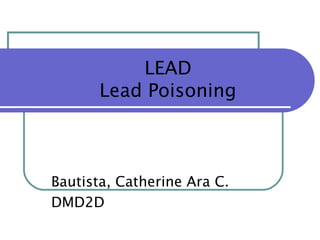
3. gen path lab bautista
- 1. LEAD Lead Poisoning Bautista, Catherine Ara C. DMD2D
- 2. Background Lead poisoning occurs when a person swallows, absorbs, or inhales lead in any form. The result can be damaging to the brain, nerves, and many other parts of the body. Acute lead poisoning, which is somewhat rare, occurs when a relatively large amount of lead is taken into the body over a short period of time. Chronic lead poisoning is a common problem in children that occurs when small amounts of lead are ingested over a longer period. At very high levels, lead poisoning can cause seizures, coma, and even death.
- 3. Exposure routes Lead-containing products Occupational exposure Water Paint Soil
- 4. Symptoms in Adult Headache Pain, numbness or tingling of the extremities High blood pressure Muscular weakness Mood disorders Miscarriage or premature birth in pregnant Declines in Reduced sperm women Memory mental loss count, functioning abnormal sperm
- 5. Symptoms in children Constipation Vomiting Sluggishness Irritability and fatigue Loss of appetite Learning difficulties Weight loss Abdominal pain
- 6. Treatment and Prevention Diagnosis - simple blood test. Serum ferritin. This is the most widely used screening method in determining blood lead levels Best prevention for lead poisoning is to avoid further contact with lead. For adults, this usually means making changes at work or in hobbies. For children, it means that parents and guardians need to find and remove sources of lead in the home. In most states, the public health department can help assess the home and identify lead sources.
- 7. Organ System affected by Lead Ischemic heart disease - condition that affects the supply of blood to the heart. Peripheral Neuropathy - is damage to nerves of the peripheral nervous system, which may be caused either by diseases of or trauma to the nerve or the side- effects of systemic illness Encephalopathy - a general term that means brain disease, damage, or malfunction.
- 8. Anemia - is a decrease in number of red blood cells or less than the normal quantity of hemoglobin in the blood. Testicular Atrophy - is Interstitial a medical condition in Nephritis - is a which form the male reproductive of nephritis affectin organs diminish in size g the interstitium of and may be the kidneys surroun accompanied by loss of ding the tubules. function
- 9. Dental Correlation Chronic Lead exposure favours the formation of cheilitis, fissures, ulcers and epithelial desquamation of the tongue, palate and other parts of the oral mucous membranes
